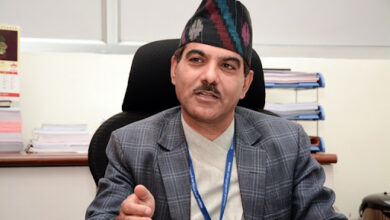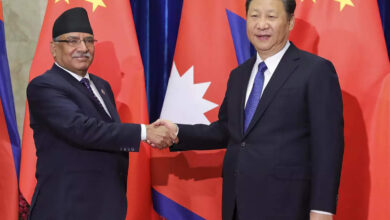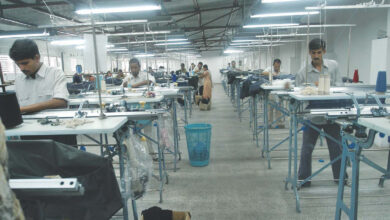Nepal’s debt servicing cost rose by over 80 percent last fiscal year
Allocated amount for debt servicing in current fiscal is more than the capital spending allocation.

By Prithvi Man Shrestha
Kathmandu : The government’s spending on debt servicing nearly doubled last fiscal year amid Nepal’s ballooning public debt along with high interest rates applicable on internal loans.
The government spent Rs222.74 billion in debt servicing, including principal repayment and interest, in the fiscal year 2022-23. The figure is a rise of around 83 percent from the previous fiscal year, according to the Public Debt Management Office (PDMO). The spending under the heading was Rs121.99 billion in the fiscal year 2021-22.
In the fiscal 2020-21, the government spent Rs95 billion in debt servicing.
The PDMO said in its Annual Report 2022-23 that a massive rise in interests to be paid to domestic creditors contributed mainly to the surge in overall debt spending.
Of the total interest of Rs72.78 billion paid last fiscal year, Rs64.51 billion went against domestic debt alone, according to the office.
The liquidity crunch in the banking system in much of the last fiscal year pushed interest rates up.
Interest rates that banks and financial institutions charge on individuals and businesses, as well as the rates that the government offered for its debt instruments such as treasury bills, development bonds, citizen saving bonds and foreign employment bonds, rose sharply.

According to the report, the average interest rate of treasury bills grew to 7.23 percent in the last fiscal year 2022-23, from 5.82 percent in the preceding fiscal. The average interest rate of development bonds, which account for around 55 percent of Nepal’s outstanding internal loans, stood at 8.64 percent in the last fiscal year from 7.74 percent in the previous fiscal.
Even though the size of domestic loans is smaller than foreign debts, the share of domestic debt finance is higher because of the costlier interest rates, the PDMO said in its annual report.
In the last fiscal, the country’s total outstanding domestic debt was Rs1,129 billion and external debt Rs1170.24 billion.
“The government is spending over four percent of the GDP in debt servicing, which is alarmingly high,” said Nara Bahadur Thapa, former executive director of Nepal Rastra Bank (NRB). The debt expenditure is considered normal if it is less than two percent of the GDP. Nepal’s GDP in the fiscal year 2022-22 stood at Rs5,381.33 billion.
He said the high debt cost means the government will have little budget for health, education, and nutrition, among others. “It affects the social sector and human development,” he added.
As debt servicing is a compulsory liability of the government, it must do that even by cutting the budget of other sectors. Dilaram Giri, information officer at the PDMO, said his office received an extra Rs22 billion last fiscal year from the finance ministry from an initial allocation to pay the debt.
The government has significantly increased the allocation for debt servicing in the current fiscal year.
According to the budget for the fiscal year 2023-24, the government will be spending as much as Rs330.55 billion in repaying loans, more than the capital budget.
The government has allocated Rs302 billion for capital spending. The amount for debt servicing accounts for 26.47 percent of the total projected revenue collection of Rs1249 billion in the current fiscal.
“Paying over a quarter of total revenue for debt servicing should be considered alarming,” said Thapa, the former central bank official.
As large amounts of internal loans will mature in the current fiscal year, the government had to allocate a vast amount for repayments, according to Giri. “The liability would be even more if the treasury bills are not rolled over for an additional period after maturity,” he added.
The budget allocates Rs275.78 billion for repaying domestic loans—both principal and interest.
According to the finance ministry, the government will spend as much as Rs93.23 billion for repaying the interest on internal loans in the current fiscal year while Rs182.55 billion has been set aside for principal payment.
Nepal started to take large loans from domestic and external creditors after the country had to undertake post-earthquake reconstruction work starting with the fiscal 2015-16.
Subsequent borrowing for spending to control the Covid pandemic increased the debt burden.
By the end of last fiscal year, the country’s total outstanding debt stood at Rs2,299.35 billion, or 42.73 percent of the GDP, according to the PDMO.
The International Monetary Fund said in its Nepal report issued in May that Nepal’s external and overall debt remains at low risk of distress, according to its debt sustainability analysis.
But, it has called for seeking more concessional financing and enhancing debt management to reduce the financing risk.
Prithvi Man Shrestha is a political reporter for The Kathmandu Post, covering the governance-related issues including corruption and irregularities in the government machinery. Before joining The Kathmandu Post in 2009, he worked at nepalnews.com and Rising Nepal primarily covering the issues of political and economic affairs for three years.




